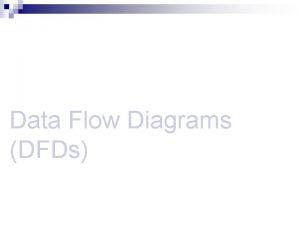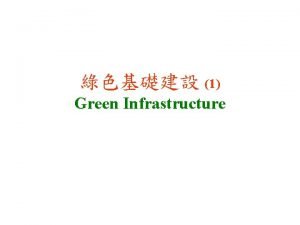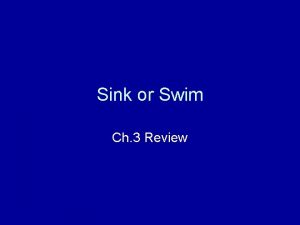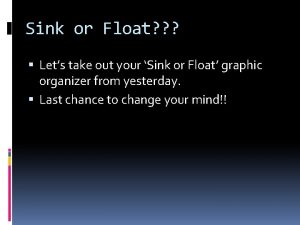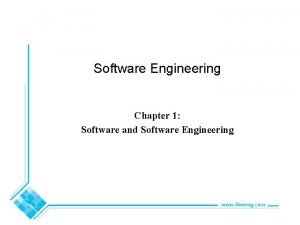Software Engineering Lecture 6 Source and Sink Analysis














- Slides: 14

Software Engineering Lecture #6

Source and Sink Analysis Sources of requirements are the origins from where the corresponding business process is initiated. By this concept, one has to trace from a requirement back to its origins to see who is involved in its initiation. Sink is the consumer of certain information. It is that entity which provides a logical end to a business process. These are logical ends of requirements, or where all the requirements are consumed.

Source and Sink Analysis • In source and sink analysis the analyst determines all the sources of requirements and where do these requirements consume (sinks). • evaluate a report which displays certain information, the source of this report is the data (and who enters it) that is input to be retrieved later in the form of the report.

Understanding the Business Domain • That is, clear understanding of the problem domain is imperative in successful delivery of a software solution. • A software developer has to develop an understanding of the business problem he is trying to solve. • Unless he develops this understanding, it is really difficult, if not impossible, to develop the right solution. • But at least if he collects both ends (sources, sinks) involved in different processes of the business system, the corresponding requirements will be

Types Of Models • Business Process Model • State Transition Model • Data Flow Model






Business Flow Example

Business process model • A patient may come to visit In Patient Department (IPD) or output patient department (OPD) • System determines if he is a company patient or a private patient. • For a company patient, system verifies him. • For an OPD patient, system will issue a chit to the patient and inform him about his number and the consultant to whom he has to consult and he will have to wait for his turn. • After verifying an IPD patient, system will create a visit and allocate him a room or a bed etc. If system cannot allocate this, then it will inform the patient. • Otherwise the patient is checked in and his information is maintained in the system. • System displays information about the expenses of the required

Business process model • Some advance payment is also received against the required service and this amount is adjusted in the final settlement. • All this information is supplied to cash office that eventually deals with payments, etc. • Upon receiving the cash, for OPD patient, a chit will be issued. For IPD patient, an admission form will be filled and this information will be maintained in the system. A receipt will be issued to the patient. • For credit transaction, corresponding voucher will be prepared. • So the model depicts process before the start of the treatment. • A patient may ask to change his service on event of an unsatisfied response from the hospital staff or any other reason. System may cancel his record and pay his amount back. • Similarly, a doctor may ask a patient to change his status from

• In a business process diagram, following points are important and should be noted – It does not describe the automated system – It only reflects the existing process of the user to help software engineer/analyst in understanding business domain. – It may contain information on processes that need not be automated.
 Sources of requirements in software engineering
Sources of requirements in software engineering Sugar source vs sugar sink
Sugar source vs sugar sink Fzero 2-100 review
Fzero 2-100 review Tracheids and vessels difference
Tracheids and vessels difference Sink y source
Sink y source Dfd completeness
Dfd completeness Source sink metapopulation
Source sink metapopulation Requirement analysis in software engineering notes
Requirement analysis in software engineering notes 01:640:244 lecture notes - lecture 15: plat, idah, farad
01:640:244 lecture notes - lecture 15: plat, idah, farad Software measurement and metrics
Software measurement and metrics System architecture example
System architecture example Forward engineering and reverse engineering
Forward engineering and reverse engineering Software maintenance process models ppt
Software maintenance process models ppt What is software implementation in software engineering
What is software implementation in software engineering What is software metrics in software engineering
What is software metrics in software engineering





